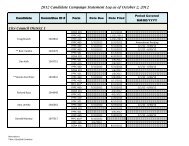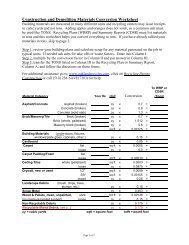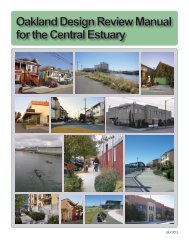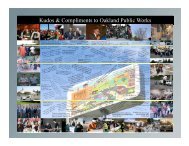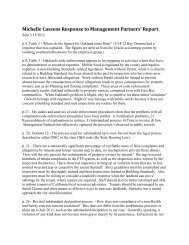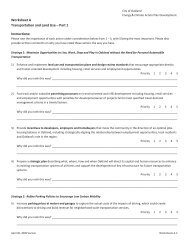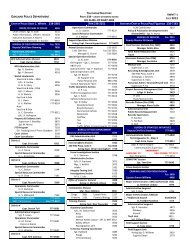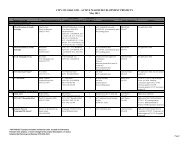Intelligent Transportation Systems - City of Oakland
Intelligent Transportation Systems - City of Oakland
Intelligent Transportation Systems - City of Oakland
You also want an ePaper? Increase the reach of your titles
YUMPU automatically turns print PDFs into web optimized ePapers that Google loves.
It is recommended that the <strong>City</strong> <strong>of</strong> <strong>Oakland</strong> continue to use pre-timed and actuated<br />
signal control and explore opportunities for traffic responsive signal control. Adaptive<br />
traffic signal control is not recommended in the near term for the <strong>City</strong> <strong>of</strong> <strong>Oakland</strong> until<br />
traffic adaptive systems have become more mature in the Bay Area. Thus, pre-timed,<br />
actuated, and traffic responsive signal control shall all be covered in the signal system<br />
functional requirements.<br />
3.2 SIGNAL SYSTEM FUNCTIONAL REQUIREMENTS<br />
The following high-level requirements for the users <strong>of</strong> a new signal system were<br />
identified by the <strong>City</strong>:<br />
• <strong>Transportation</strong> Services and Electrical Services shall have the ability to monitor and<br />
control the <strong>City</strong>’s traffic signals from a central location on a real-time basis.<br />
• <strong>Transportation</strong> Services, in coordination with the Fire Department, shall have the<br />
ability to adjust signal timing in response to incidents and emergencies on a real-time<br />
basis.<br />
These high-level requirements address the <strong>City</strong> <strong>of</strong> <strong>Oakland</strong> ITS Program Goals and<br />
Objectives described in Section 1, as shown in Table 3.1 below.<br />
Table 3.1: <strong>City</strong> <strong>of</strong> <strong>Oakland</strong> ITS Goals and Objectives Mapped to<br />
High-Level Signal System Requirements<br />
Goals Objectives High-Level<br />
Requirements<br />
• Improve vehicle travel times in <strong>Transportation</strong> Services<br />
congested corridors by and Electrical Services<br />
coordinating traffic signals shall have the ability to<br />
and responding to changing monitor and control the<br />
traffic conditions.<br />
<strong>City</strong>’s traffic signals from<br />
• Provide travelers with good a central location on a<br />
information to enable tripmaking<br />
real-time basis.<br />
decisions.<br />
• Coordinate transportation<br />
operations with other major<br />
transportation agencies in the<br />
<strong>Oakland</strong> area, including Port<br />
<strong>of</strong> <strong>Oakland</strong>, SMART Corridors<br />
and Caltrans.<br />
Reduce congestion and<br />
improve traffic flow by<br />
developing an integrated<br />
roadway and traffic demand<br />
management system that<br />
provides an appropriate mix <strong>of</strong><br />
mobility and accessibility<br />
throughout the <strong>City</strong>.<br />
Improve the environment by<br />
reducing fuel consumption and<br />
air pollutants caused by<br />
vehicles.<br />
Provide safe streets. • Improve safety and security <strong>of</strong><br />
motorists, transit users,<br />
bicyclists and pedestrians.<br />
• Coordinate transportation<br />
operations with emergency<br />
service providers in response<br />
to incidents and emergencies.<br />
<strong>Transportation</strong> Services,<br />
in coordination with the<br />
Fire Department, shall<br />
have the ability to adjust<br />
signal timing in response<br />
to incidents and<br />
emergencies on a realtime<br />
basis.<br />
<strong>City</strong> <strong>of</strong> <strong>Oakland</strong> ITS Strategic Plan<br />
22 September, 2003




